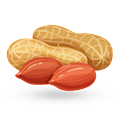Oncom is a traditional product that is fermented with mold. The base of every oncom is prepared with various by-products such as soy pulp, peanut and coconut press cake, or cassava tailings that are fermented with two types of mold to create red and black oncom varieties.
Often praised for its low cost and high nutritional value, oncom can be enjoyed as a stand-alone snack or wrapped in banana leaves. It is mainly produced and consumed in West Java.
Arem-arem is a Indonesian snack hailing from Java. It consists of a cylindrical rice cake that's wrapped in a banana leaf. The snack is stuffed with tempeh, chopped vegetables, oncom, or abon beef floss. There are many variations on arem-arem, so no fixed recipe really exists.
The rice is usually flavored with coconut milk. Arem-arem can be found in Indonesian markets, and it's often served for birthdays, meetings, or family gatherings.
Panada is an interesting Indonesian take on Spanish and Latin American empanadas. These deep-fried, crescent-shaped pastries consist of leavened dough and a fish-based filling. The Indonesian version is traditionally filled with a combination of skipjack tuna, onions, coconut milk, chili peppers, and other optional ingredients.
The name of this convenient snack unmistakably resembles Spanish empanadas—small pies that originated in Galicia, but which have become a staple in Latin American countries. However, it is believed that the origin of panada was influenced by the Portuguese, who were present in the area since the 16th century.
MAIN INGREDIENTS
Krupuk udang is a type of traditional Indonesian shrimp cracker, made from a mixture of ground shrimp, tapioca flour, garlic, and seasonings, which is then sun-dried and deep-fried until it puffs up into a light, crispy snack.
The word krupuk (or kerupuk) means “cracker”, and udang means “shrimp”. These crackers are known for their savory, umami-rich flavor with a subtle seafood aroma, making them one of the most popular accompaniments to Indonesian meals.
MAIN INGREDIENTS
Kerak telor is a traditional omelet and a specialty of the Betawi people in Jakarta and West Java. The omelet is usually served as a snack and consists of glutinous rice that’s cooked with chicken or duck eggs. Once done, the omelet is sprinkled with serundeng (fried shredded coconut), dried shrimp, and fried shallots.
This dish is often prepared by street vendors who serve it from their carts during the annual Jakarta Fair.
MAIN INGREDIENTS
Laklak is a traditional Balinese pancake, made from rice flour and recognizable by a distinctive green color, which usually comes from pandan leaves.
The batter for laklak is poured into special half-sphere molds and cooked over a fire, resulting in a fluffy texture on the inside with a slightly crispy exterior. Laklak is typically served with a drizzle of coconut syrup or palm sugar syrup and sprinkled with grated coconut on top, enhancing its sweet and savory taste.
MAIN INGREDIENTS
Nagasari is a traditional cake. It's made with flour and coconut milk batter and slices of banana. The combination is wrapped in banana leaves, then steamed to perfection. The texture is soft, creamy, and slightly wobbly. The batter is usually made with a mix of ripe bananas, rice flour, tapioca flour, coconut milk, vanilla, sugar, and salt.
Once done, the rice cake is served warm or at room temperature. Nagasari is a popular snack that can be found throughout the country and it's sold in most food markets.
Kue cucur is a traditional snack that's also popular in Malaysia (kuih cucur) and Thailand (khanom fak bua). It's made with a combination of palm sugar, fried rice flour, and coconut milk that's fried until crispy. This sweet snack is usually flattened on the edges so that it remains thick in the middle.
The most popular Indonesian version is the Betawi variety from Jakarta. In Thailand, kue cucur is similar to a lotus, which is believed to represent love of a newly married couple, so it's often prepared at Thai weddings and festivals. Kue cucur is served hot, warm, or at room temperature, and it's best to eat it while it's still fresh, otherwise it will become sticky and stiff.
Rengginang is a traditional rice cracker originating from Indonesia. It's made from dried leftover sticky rice that's seasoned with spices, flattened and shaped into a circle, then sun-dried and deep-fried in oil. This type of rice cracker is different from most other rice crackers because the rice grains are clearly visible.
The texture of rengginang should always be crispy, while the flavors can be savory or sweet. It can be enriched with the addition of terasi shrimp paste or dried prawns. In Suriname, this cracker is known as brong-brong.
Bakpia pathok is an Indonesian delicacy that consists of a round, slightly flattened pastry filled with a sweet mung bean mixture. The pastry is characterized by a soft and flaky texture, while its interior, containing the filling, has a pasty consistency that perfectly adheres to the dough.
Its name derives from a suburb area in the city of Yogyakarta called Pathok, where the production of these pastries initially began. Apart from the traditional mung bean filling, bakpia pathok can nowadays be made with chocolate, cheese, and exotic fruits such as pineapple or durian fruit.
TasteAtlas food rankings are based on the ratings of the TasteAtlas audience, with a series of mechanisms that recognize real users and that ignore bot, nationalist or local patriotic ratings, and give additional value to the ratings of users that the system recognizes as knowledgeable. For the “14 Worst Rated Indonesian Snacks” list until April 19, 2025, 1,128 ratings were recorded, of which 679 were recognized by the system as legitimate. TasteAtlas Rankings should not be seen as the final global conclusion about food. Their purpose is to promote excellent local foods, instill pride in traditional dishes, and arouse curiosity about dishes you haven’t tried.










